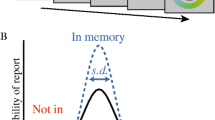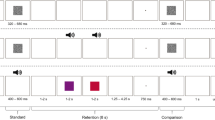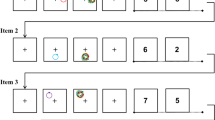Abstract
Based on cognitive load theory and the transient information effect, this paper investigated the modality effect while interpreting a contour map. The length and complexity of auditory and visual text instructions were manipulated. Experiment 1 indicated that longer audio text information within a presentation was inferior to the equivalent longer visual text information demonstrating a reversal of the modality effect due to transient information imposing a heavy working memory load. However, the expected modality effect was not obtained from the equivalent shorter auditory text presentation compared to shorter visual text information. It was hypothesised that the shorter text still contained too much auditory information for working memory to readily process. Experiment 2 further decreased the shorter auditory text information which then resulted in a traditional modality effect including a modality by text length interaction in which shorter, audio-visual information was better than visual only information but longer, audio-visual information was worse than visual only information.




Similar content being viewed by others
References
Ayres, P. (2006). Using subjective measures to detect variations of intrinsic cognitive load within problems. Learning and Instruction, 16(5), 389–400. doi:10.1016/j.learninstruc.2006.09.001.
Baddeley, A. (1992). Working memory. Science, 255, 556–559. doi:10.1126/science.1736359.
Bartlett, F. C. (1932). Remembering: a study in experimental and social psycholog. London: Cambridge University Press.
Chi, M., Glaser, R., & Rees, E. (1982). Expertise in problem solving. In R. Stemberg (Ed.), Advances in the psychology of human intelligence (pp. 7–75). Hillsdale, NJ: Erlbaum.
De Groot, A. (1965). Thought and choice in chess. The Hague, Netherlands: Mouton.
Ericsson, K. A., & Kintsch, W. (1995). Long-term working memory. Psychological Review, 102, 211–245. doi:10.1037/0033-295x.102.2.211.
Ginns, P. (2005). Meta-analysis of the modality effect. Learning and Instruction, 15, 313–331. doi:10.1016/j.learninstruc.2005.07.001.
Gopher, D., & Braune, R. (1984). On the psychophysics of workload: Why bother with subjective measures? Human Factors, 26, 519–532.
Kalyuga, S. (2007). Expertise reversal effect and its implications for learner-tailored instruction. Educational Psychology Review, 19(4), 509–539. doi:10.1007/s10648-007-9054-3.
Leahy, W., & Sweller, J. (2011). Cognitive load theory, modality of presentation and the transient information effect. Applied Cognitive Psychology, 25(6), 943–951. doi:10.1002/acp.1787.
Mayer, R. E. (2009). Multimedia learning. New York: Cambridge University Press.
Mayer, R. E., & Moreno, R. (1998). A split-attention effect in multimedia learning: Evidence for dual-processing systems in working memory. Journal of Educational Psychology, 20, 312–320.
Mayer, R. E., & Moreno, R. (2003). Nine ways to reduce cognitive load in multimedia learning. Educational Psychologist, 3(1), 43–53.
Mayrath, M. C., Nihalani, P. K., & Robinson, D. H. (2011). Varying tutorial modality and interface restriction to maximize transfer in a complex simulation environment. Journal of Educational Psychology, 103(2), 257–268. doi:10.1037/a0022369.
Miller, G. A. (1956). The magical number of seven, plus or minus two: Some limits on our capacity for processing information. Psychological Review, 63, 81–97. doi:10.1037/h0043158.
Moreno, R. E., & Mayer, R. E. (1999). Cognitive principles of multimedia learning: The role of modality and contiguity effects. Journal of Educational Psychology, 91, 358–368. doi:10.1037/0022-0663.91.2.358.
Morrison, D. (2004). Middle years geography. Sydney: Blake Education.
Newell, A., & Simon, H. A. (1972). Human problem solving. Englewood Cliffs, NJ: Prentice Hall.
Paas, F., Tuovinen, J. E., Tabbers, H., & Van Gerven, P. W. M. (2003). Cognitive load measurement as a means to advance cognitive load theory. Educational Psychologist, 38(1), 63–71.
Penney, C. G. (1975). Modality effects in short-term verbal memory. Psychological Bulletin, 82, 68–84.
Penney, C. G. (1989). Modality effects and the structure of short term verbal memory. Memory and Cognition, 17, 398–422.
Peterson, L. R., & Peterson, M. J. (1959). Short-term memory retention of verbal items. Journal of Experimental Psychology, 58, 193–198. doi:10.1037/h0049234.
Schmidt-Weigand, F., Kohnert, A., & Glowalla, U. (2010). A closer look at split visual attention in system- and self-paced instruction in multimedia learning. Learning and Instruction, 20(2), 100–110. doi:10.1016/j.learninstruc.2009.02.01.
Sweller, J. (2010). Element interactivity and intrinsic, extraneous and germane cognitive load. Educational Psychology Review, 22, 123–138. doi:10.1007/s10648-010-9128-5.
Sweller, J. (2011). Cognitive load theory. In J. Mestre & B. Ross (Eds.), The psychology of learning and motivation: Cognition in education (Vol. 55, pp. 37–76). Oxford: Academic Press.
Sweller, J. (2012). Human cognitive architecture: Why some instructional procedures work and others do not. In K. Harris, S. Graham, & T. Urdan (Eds.), APA educational psychology handbook (Vol. 1, pp. 295–325). Washington, D.C.: American Psychological Association.
Sweller, J., & Sweller, S. (2006). Natural information processing systems. Evolutionary Psychology, 4, 434–458.
Sweller, J., van Merrienboer, J., & Paas, F. (1998). Cognitive architecture and instructional design. Educational Psychology Review, 10, 251–296.
Tabbers, H. K., Martens, R. L., & van Merrienboer, J. (2004). Multimedia instructions and cognitive load theory: Effects of modality and cueing. British Journal of Educational Psychology, 74, 71–81. doi:10.1348/000709904322848824.
Williams, J. R. (1998). Guidelines for the use of multimedia in instruction. In proceedings of the human factors and ergonomics society 42nd annual meeting (pp. 1447–1451).
Wong, A., Leahy, W., Marcus, N., & Sweller, J. (2012). Cognitive load theory, the transient information effect and e-learning. Learning and Instruction, 22(6), 449–457. doi:10.1016/j.chb.2008.12.012.
Author information
Authors and Affiliations
Corresponding author
Appendices
Appendix 1
The 10 questions used in Ex 1 & Ex 2
Appendix 2
Subjective cognitive load rating scale used in Ex 1 & 2.
Rate how easy/difficult you found this presentation to understand with an X | ||||||
|---|---|---|---|---|---|---|
1 | 2 | 3 | 4 | 5 | 6 | 7 |
Very easy | Easy | Moderately easy | Not easy nor difficult | Moderately difficult | Difficult | Very difficult |
Appendix 3
For the longer audio text and longer visual text groups times in seconds (s) and number of words for each slide viewing time in Experiments 1 & 2 (to nearest whole number).
Slide 1: 60 s (74 wds), Slide 2: 15 s (16 wds), Slide 3: 24 s (26 wds), Slide 4: 34 s (39 wds), Slide 5: 70 s (55 wds), Slide 6: 90 s (75 wds), Slide 7: 90 s (75 wds), Slide 8: 190 s (10 wds—a question) and Slide 9: 90 s (75 wds—the answer).
Appendix 4
For the shorter audio text and shorter visual text groups. Times in seconds (s) and number of words for each slide viewing time- (to nearest whole number) in Experiment 1.
Slide 1: 11 s (10 wds), Slide 2: 12 s (17 wds), Slide 3: 13 s (14 wds), Slide 4: 12 s (19 wds), Slide 5: 12 s (13 wds), Slide 6: 15 s (16 wds), Slide 7: 10 s (7 wds), Slide 8: 13 s (20 wds), Slide 9: 13 s (13 wds), Slide 10: 12 s (18 wds), Slide 11: 10 s (9 wds), Slide 12: 25 s (23 wds), Slide 13: 10 s (21 wds), Slide 14: 35 s (24 wds), Slide 15: 7 s (10 wds—a question), Slide 16: 16 s (15 wds), Slide 17: 35 s (23 wds), Slide 18: 14 s (14 wds), Slide 19: 18 s (11 wds),
Slide 20: 7 s (10 wds—a question), Slide 21: 16 s (15 wds), Slide 22: 35 s (23 wds), Slide 23: 14 s (14 wds), Slide 24: 18 s (11 wds), Slide 25: 190 s (10 wds—a question), Slide 26: 18 s (15 wds), Slide 27: 38 s (23 wds), Slide 28: 16 s (14 wds) and Slide 29: 18 s (11 wds).
Rights and permissions
About this article
Cite this article
Leahy, W., Sweller, J. Cognitive load theory and the effects of transient information on the modality effect. Instr Sci 44, 107–123 (2016). https://doi.org/10.1007/s11251-015-9362-9
Received:
Accepted:
Published:
Issue Date:
DOI: https://doi.org/10.1007/s11251-015-9362-9




